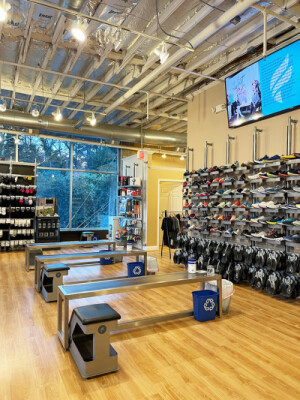There are valid reasons a running store might pursue becoming a more sustainable, eco-conscious retail operation.
One, consumers, especially younger ones, continue expressing an affinity for businesses employing an environmental ethos. A 2021 Shopify-commissioned survey conducted by Forrester Consulting reported that nearly half of consumers are more likely to buy from a brand with a clear commitment to sustainability.
Two, there’s a dollars-and-cents case to improving sustainability in brick-and-mortar storefronts. Using resource and energy-efficient products, from lightbulbs to low-flow toilets, sparks savings that head directly to a store’s bottom line. According to a report by McKinsey, energy is a retail store’s fourth largest operating expense behind labor, rent and marketing, so some strategic investments can result in real savings.
And three, there’s an ethical component to environmental stewardship, especially for an industry that leans into the outdoors. Being kind to earth is the right thing to do and, if nothing else, generates good karma.
While installing solar panels, geothermal heat pumps or replacing old windows are headline-grabbing investments, those will be challenging pursuits for many, especially running shops who lease their spaces. Still, running stores can do a number of simpler, more accessible things to demonstrate their environmental ethos and support Mother Earth’s health.
1. Be a shoe recycling center.
Many running stores are on the shoe-recycling bandwagon and it is perhaps the easiest sustainability bandwagon for run shops to hop on. Collecting used shoes for organizations like Soles4Souls, the MORE Foundation or a local shelter puts old running shoes to good use elsewhere and prevents them from ending up in a landfill. Added bonus: hosting an in-store shoe recycling effort also drives traffic into the store. (A look at two of these efforts begins on page 32.)
2. And speaking of recycling.
Running shoes often come filled with paper and cardboard, much of which is first touched by sales associates on the sales floor. To encourage recycling, place blue recycling bins near fit stools so staff can easily and quickly place paper and cardboard where it belongs.
After a shoe purchase, staff can also ask if they would like the store to recycle the box, if not verbally then perhaps with a sign near the register that says, “If you don’t need your shoe box, we’d be happy to recycle it for you.” The latter, in particular, spotlights a store’s environmental mindset.
3. Merchandise with a green thumb.
Rather than purchasing new product displays, consider upcycling previously loved items. A wooden hutch, for instance, can be repaired and repainted to become a showroom focal point and a host for accessories or T-shirts.
4. Promote reuse.
Running Insight recently shared the story of the consignment area at Fartleks Running Shop Smoothie Stop in Wichita, KS. While the consignment area is a revenue and traffic-generating tool for Fartleks, the sustainable angle cannot be ignored. By reselling used fitness apparel, Fartleks extends the life of gear and reduces waste.
5. Actively source sustainable.
Brands across the running industry landscape – as this special sustainability-themed issue of Running Insight shows – continue to introduce footwear, apparel, socks and accessories with a sustainable bent. Spotlight these products in e-mails or special in-store signage. Also, arm staff with the necessary information to discuss a product’s eco-conscious features with customers.
6. Ditch the paper receipt.
A receipt might not look like much, but a lot goes into creating receipts – trees, oil and water. Then, those receipts get discarded. Many point-of-sale units now allow for digital receipts, so consider activating that option to save paper and money.
7. Save energy, save money.
To reduce electrical use, stores can switch to more energy-efficient LED lightbulbs and use motion-activated lights in the stockroom. On the water conservation front, stores might install low-flow toilets, motion-activated faucets or aerators on the end of a faucet to reduce water use. Much like the familiar Energy Star label for energy efficiency, the U.S. Environmental Protection Agency’s WaterSense label signals a water-efficient product.
Of note, many municipalities and utilities offer rebates on high-efficiency products to trim the up-front expense of going green.
8. Tackle heating and air.
Heating and air are two of a storefront’s biggest energy-sucking culprits, collectively accounting for as much as 50 percent of a retail store’s energy consumption.
With a programmable or smart thermostat, operators can align the store temperature to its operating hours. Program the unit to a comfy 72 degrees during the day and then turn the heat or AC down during dark hours to reduce energy use and save money. By lowering the thermostat 7-10 degrees for eight hours a day, stores can expect to reduce their energy consumption about 10 percent, according to U.S. Department of Energy estimates.
Operators can also reduce energy use by sealing cracks around doors and windows and turning heating or AC off on pleasant days when doors and windows can be opened for natural ventilation.
9. Get an energy audit.
Just as the name suggests, an energy audit is a professional analysis of a storefront’s energy use. While some utilities offer energy audits – often, though not always, a high-level overview resulting in rather generic interventions – stores can also hire a private auditor to conduct a more thorough analysis generating specific energy and cost-saving measures a business might take to increase its energy efficiency and reduce its carbon footprint. n







